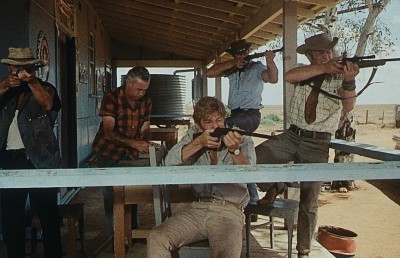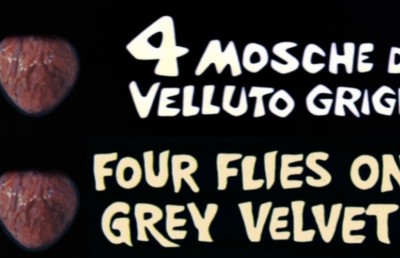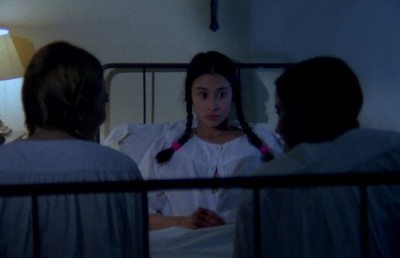European Western vs. American Western
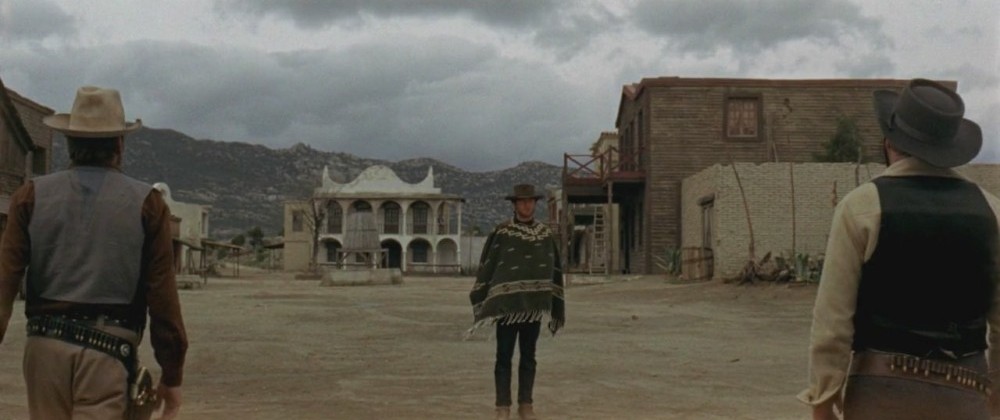
Introduction
This essay is concerned with some of the major elements that distinguish Italian westerns [1] from Hollywood westerns. A Fistful of Dollars (1964, dir. Sergio Leone) epitomises a cinematic matrix where all these differences are manifest. This film is not the first Italian western, so why is it being considered as the main cinematic text for this writing? Two reasons, invoked in the quotes below, are its generic innovations and its unexpected financial success:
1. Peter Bondanella (1996, p.255) writes: “much of the impact of Leone’s first western was generated by its conscious departures from what had come to be known as the ‘classic’ western formula.” Moreover, Thomas Weisser cited in Paul Cooke’s Dialogues with Hollywood (2007, p.179) argues that “the movie (A Fistful of Dollars) is responsible for the popularity of the Spaghetti [2] western genre. It set a standard, designed a roadmap for a violently nihilistic cinematic style that dramatically separates Euro westerns from the Hollywood variety.”
2. Cooke (2007, 179) writes that “A Fistful of Dollars was an enormous box-office success, taking more money than any other Italian film to that date and reinvigorating the Italian film industry.”
Hence the combined force of the film’s box-office clout, which ensured the continuity of the Italian western, and its artistic impact, made the European western a cinema worthy of scrutiny by scholars and critics.
This essay will first identify and then examine four fundamental differences between American and Italian westerns.
The effects of Italian neo-realism
Although Italian westerns are popular films, they are nevertheless affected by some of the conventions of a less popular group of films, Italian neo-realism. This is not to say that the Italian westerns are pure artistic pictures which try to manifest the socio-political issues of their day and rekindle the consciousness its people. On the contrary, these films were entertainment vehicles aimed at providing audiences with a break from the reality of everyday life.
The first aspect that recalls neo-realism is the use of (on-location) sets. In the opening minutes of A Fistful of Dollars, the audience observes the man with no name, Joe (Clint Eastwood), entering the border town of Saint Miguel (shot in the desert regions of Almeria, Spain). The town, although populated, is depicted as a ghost town. The emptiness of the streets portrays the total lack of all concepts that make relations between humans dynamic: love, respect, humility, sacrifice, understanding and above all, law. The sets contribute immensely to this portrayal by being simple and white, like the pale face of the dead person who rides horse back into the town. It can also be said that this whiteness is a façade concealing the dark side of a town destroyed and corrupted as the result of gang wars.
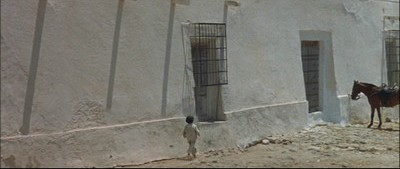
In addition to the sets, the realistic make-up of the characters is also borrowed from neo-realist cinema. In both cases, the make-up is not solely an artistic attempt to present a character’s appearance, but a medium for encoding a message that goes beyond character: the unshaven, dirty and sunburnt faces of the characters illustrating the brutal environment which envelops them. Frayling (2006, p.126) explains the source of this realistic view by writing: “Leone often bases his characters’ appearance on nineteenth century photographs.” Joe is a handsome man, but this beauty is distorted by the make-up. In contrast to this, in the American westerns of John Ford or Howard Hawks, no matter how unfavourable the situation, the characters still have time for a shave and bath –that is, they look tidy and clean. This smartness represents the idealistic nature of a strong and tough American subject; Americans like to see their heroes well-groomed.
The above visual elements suggest that the content and philosophy of A Fistful of Dollars can be read in neo-realist terms. The main similarity is that in both cases the characters are trapped by their lives. Leone in Frayling (2006, p.131) says that his characters are inspired by the characters of Sicilian theatre because they are “working within a fairly restricted margin.” However, the representation of ‘being trapped’ differs in westerns and neo-realist films. In the latter, the characters initially do their best to change the situation, but to no avail; they barely survive. On the other hand, in Italian westerns the environmental conditions of the characters are so cruel and unpleasant that they cannot expect any form of survival. They either succeed entirely, or lose it all.
It is due to the above doctrine that ‘money’ is so important in these films. According to Frayling (2006) and Cooke (2007), if in the case of American westerns money is a tool or way for reaching a higher goal (a woman’s love, helping others, escaping a hard life), in Italian westerns it is the ultimate objective. Frayling (2006, p.51) explains this idea as such: “The ‘hero’ does not spend his dollars: he treats them strictly as ‘prize’, as ‘something that must be grabbed before the next man reaches them.’ ” In the case of A Fistful of Dollars, Leone encodes this message to the audience by keeping them in the dark about why Joe needs all the money. From what we can gather, there are other people who need the money more than him. Even Ramón (Gian Maria Volonté), the antagonist, can be said to deserve the money more than Joe because he is in charge of a large gang. Nevertheless, by observing that one person has all the money at the end, viewers can infer that when a society is in trouble, those who can stand for themselves will survive.
The re-conceptualisation of violence
The representation of violence in Italian westerns differs fundamentally from the American westerns. The re-conceptualisation of violence in the former is a reflection of violence in the Italian society of the 1960s. Lino Micciché cited in Frayling (2006, p.55) explores this notion by writing: “the Italian Westerner … [is] a commonplace of the everyday psyche of the ‘average’ Italian [who has] the urge to overwhelm … in order not to be overwhelmed, the urge to guarantee that you will not become anyone’s victim.” This everydayness of violence is the first level of difference from Hollywood films. In the latter, a community [4] and/or a person [5] seeks peace. The obstacle to peace arises from the usage of violence by others. However, in Italian westerns the protagonist or the community has another approach. They utilise violence not for defending themselves, but for avoiding being violated. Whereas in Hollywood films the proper etiquette is to calm the situation, in Italian films the protagonist aims to provoke violence as much as possible. Joe proves this notion in the first fifteen minutes of A Fistful of Dollars by murdering four people because they make fun of his mule.
The next point is that Italians are more explicit than Americans in their depiction of violence. According to Frayling (2006), in tandem with some other American directors, John Ford did not like European westerns because they were “too violent.” Moreover, John Cawelti in Bondanella (1996, p.235) writes that “[in] the classic [American] westerns … violence was the fault of evil and corrupt men.” I think that Ford and others failed to understand the representation of violence in Italian westerns; unlike the American western, in the Italian western violence does not have symbolic or moral meaning. For example, in The Man Who Shot Liberty Valance (1962) John Ford represents the antagonist, Liberty Valance (Lee Marvin), as the villain by portraying him as a thief and a brutal man. Valance tears apart Ransom Stoddard’s (James Stewart) law books to illustrate that his character is an outlaw. Moreover, he kicks Stoddard to establish himself as a violent man; but there are no shotguns, no vulgar language and even the kicking is not that harsh. However, Ford sets Valance apart as a violent antagonist with the use of symbols (e.g. law books).
The essential contrast to the above example is the way that Leone portrays his antagonist, Ramón (Gian Maria Volonté), in A Fistful of Dollars. Prior to Ramón’s first appearance in the film, Joe (and hence the spectators) learns from the film’s characters that Ramón is an artist with a gun; and that he shows little mercy towards others. Tension is built leading up to Ramón’s introduction at approximately twenty-five minutes. The audience wonders: “is he really that good with guns?” “is he really a vicious man?” Using violence in a symbolic manner not only bypasses the generic codes of the Italian western, but destroys the suspense generated around the antagonist. Leone cleverly avoids any symbolic attempt at the antagonist’s portrayal. Therefore, the first time that the audience encounters Ramón is when he is behind an automatic machine gun slaughtering a whole platoon. Furthermore, his great marksmanship is demonstrated when a wounded soldier tries to escape and Ramón shoots him dead with his Winchester rifle at distance. In Italian westerns characters are privileged with an absolute freedom to use violence.
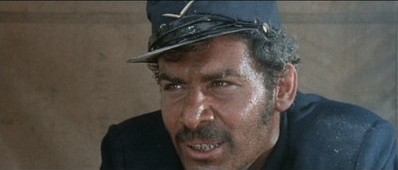
The secularisation of Biblical themes
As Bertrand Russell (1961) espouses, Judeo-Christian traditions have had a great influence on Western culture and art. Biblical themes can always be found in the films of both continents. Bertellini (2004) believes that the man with no name’s visit to Saint Miguel can be likened to the entrance of Jesus to Jerusalem. The evidence is tangible; he is coming from the desert on a mule; and he enters a corrupt town with the aim of making changes. Up to this point the narrative is classically Biblical. However, the contrast starts from the point the audience learns that Joe is not trying to bring salvation for others, but for himself. If Jesus brought the message of ‘love’ and ‘peace’ to Jerusalem, Joe conveys concepts of ‘death’ and ‘personal gain’ to Saint Miguel.
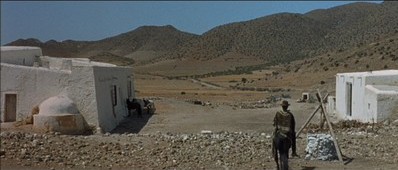
The above claim can be contested if one considers that towards the end of the film Joe saves the honour of a young woman, Marisol (Marriane Koch), and reunites her with her family. He also saves her life by not telling Ramón of her whereabouts, an act which leads to his torture. Nevertheless, this act of self-sacrifice helps Joe as well as Marisol. When Marisol asks him why he is helping her, he responds: “I knew someone like you. No one was there to help her.” This response perhaps suggests that in the past Joe was a simple man without the skills of a hero, like most of the film’s viewers. If this is seen as an admission of self-defeat, then helping Marisol allows him to overcome personal demons. Therefore, the spectators learn that to be useful to themselves and others, they need to be as strong as Joe.
The Biblical ethos of Italian westerns is also different from the American films. In American westerns the concept of God shapes the faith and destiny of its people; whereas in Italian westerns God does not intervene and is absent from the films. In the Hollywood western the incarnation of God is often likened to the idea of the ‘Garden’. Cooke (2007) argues that seeking the garden –that is, the idea of the family in a developed land– is the most significant ideology of American westerns. In the last sequence of The Man Who Shot Liberty Valance, Hallie Stoddard (Vera Miles) tells her husband that their hometown (Shinbone) was once an undeveloped land, but now it is a garden. Many western film critics have suggested that the garden is an allusion to the Garden of Eden, and America, with its newly ‘civilized’ land, representing a new Garden of Eden.
In opposition to this usage of Biblical themes, Leone gives us a secular version of God. The signs and icons of a divine being are indeed present: crosses, churches, the platonic man with no name (like Jesus), and so on. However, God does not challenge the violent men of Saint Miguel. He lets them sort their problems out on their own. [6] This forms the ideological rationale as to why the Italian westerns are violent; God has left us already, so we can do whatever we want. Even Joe’s deeds do not bring peace to Saint Miguel. He simply annihilates the men and leaves the town before the American and Mexican armies enter.
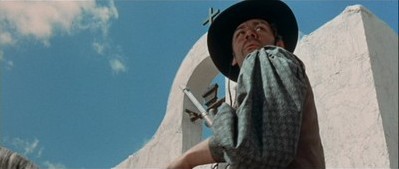
The invention of the modern antagonist
The nature of the antagonist is the most significant difference demarcating Italian and American westerns; the Italian antagonist is totally distanced from the American variant. The latter, as a one-dimensional character, is simply ‘a bad man’; but this badness is not defined by the film, or explained in any depth. Instead the character of the antagonist is a nexus of clichés: he drinks a lot, he is not a gentleman, he is a troublemaker, he is the one most likely to provoke needless acts of violence, and above all he stands outside the community, an outcast, which means he is hated by the townspeople. This type of representation is simplistic because the audience is not given the chance to really understand why he behaves differently. If drinking and shouting make men evil, so too are the majority of today’s university students. Films should develop or at least suggest more profound elements as to why some men act differently than others.
Italian westerns set out to change the traditional way that westerns depict antagonists. Cooke (2007, p.180) writes: “Leone, by breaking and playing with conventions, established a new template for the western based on liminality and complexity rather than a simple binary system of good versus bad.” To do so, Leone reduces the space between antagonist and protagonist. Moreover, the personalities of the two characters can overlap. This is not an arbitrary attempt, but something that requires certain rules and tactics. They are:
1. Physical appearance; this means that the antagonist’s and the protagonist’s features are similar. In A Fistful of Dollars, Ramón is almost as tall as Joe, and his gun fighting abilities are at Joe’s level. Moreover, both of them have the same make-up (gruff exterior, unshaven, etc.). Cooke elucidates this resemblance. He (2007, p.180) writes: “[the antagonist] is as powerful and charismatic as the hero, in order to maintain interest and give the hero a real challenge.” Therefore, it can be said, based on Cooke’s idea, that the antagonist must be a worthy adversary; if not, there is no point for the protagonist to face up to him.
2. Character establishment; both antagonist and protagonist establish their presence in the film through the killing of others. The difference is that the antagonist kills more often than the protagonist. As the result of using violence for the purpose of identity, the death of the antagonist carries more meaning than the death of his counterpart in an American western. According to Bondanella (1996), if in an American western the antagonist’s death simply means the triumph of the virtuous, in an Italian western it encompasses the narrative. [7]
3. Heterosexual love; there is always a love interest between a man and woman in Hollywood films and this follows in many American westerns as well. The convention is that the hero falls in love with a woman, but can’t attain her. The reasons are either that she marries another man (e.g. The Searchers, The Man Who Shot Liberty Valance), or she has been murdered (Red River). Moreover, even if he does fall in love with a married woman, he is gentleman enough to avoid a sexual affair (Shane). Italian westerns re-contextualise the notion of love. By this I contend that women often are not portrayed as romantic objects. They are lost in the hierarchical system of the masculine society of these films. Moreover, they are too feeble to be loved by the protagonist. As noted before, the hero looks for strong and challenging characters. It can even be said that when it comes to women, the hero is asexual. In addition, in these films it is the antagonist who is more likely to fall in love (like Ramón who loves Marisol). This love is not the conservative and romantic love of Hollywood, e.g. to enact on his love for Marisol, Ramón separates her from her child and husband, bringing dysfunction upon her family life.
4. Selfishness; in Hollywood films, one element of the protagonist’s character is that he is unselfish and down to earth. The character of Tom Doniphon (John Wayne) in The Man who shot Liberty Valance is an ideal example. In opposition to this, the protagonist in the Italian western cares for no one and nothing, outside of his personal gain. As noted earlier in A Fistful of Dollars, Joe’s goodwill act toward Marisol still serves a personal purpose. The irony is that in these westerns, the antagonist is usually more caring and unselfish than their counterparts. This does not necessarily mean that he is a decent or lovable man, but that as long as people stay within his rules he will not bother them. Ramón shows his hatred to the protagonist only when Joe causes Marisol to leave him. In Hollywood films, the antagonist has few friends and many enemies; this formula is echoed in Italian westerns, where it is the protagonist who has few friends and many enemies.
Conclusion
Among the four changes that Leone established in A Fistful of Dollars, the most significant one is the representation of the villain. The traditional bad man of Hollywood no longer carries the same weight. Viewers today are only satisfied by complex and menacing villains. In the last few years characters such as the Joker (Heath Ledger) in The Dark Knight (dir. Christopher Nolan, 2008) and Bill “The Butcher” Cutting (Daniel Day-Lewis) in Gangs of New York (dir. Martin Scorsese, 2003) epitomise this change.
As all the above dichotomies suggest, the Italian western is not a sub-genre of the Hollywood western, but a genre of its own. [8] The westerns of both traditions are different in terms of visual style, theme, and characterisation. They may be grouped together as westerns, but they function under differing semantic and syntactic patterns. To quote an ancient Iranian proverb, “not every round object signifies the walnut.”
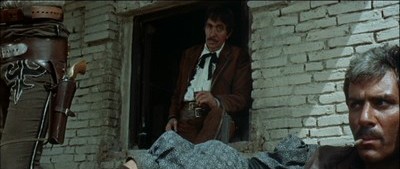
Endnotes
1 According to Christopher Frayling cited in Bertellini (2004, p.163), “between 1962 and 1976, over 450 westerns were produced in Italy or involved an Italian financial interest.”
2 The term Spaghetti western has been considered derogatory by some scholars, as discussed by Dimitris Eleftheriotis (2001, p.92), because of the way it [spaghetti] “connotes inferiority and foreignness.” However, Dimitris Eleftheriotis uses the term as a springboard for theoretical and critical discussion around issues of genre. My own preference for this essay is to use the term ‘Italian Western.’
3 Frayling (2006) says that the film’s budget was 200,000 US dollars; it earned 8 million Dollars worldwide
4 As an example, Shane (dir. George Stevens, 1953).
5 As an example, The Searchers (dir. John Ford, 1956).
6 This reminds one of a contemporary Hollywood film, Blood Diamond (dir. Edward Zwick, 2006). In the film, the protagonist Danny Archer (Leonardo DiCaprio) explains the acts of violence in Africa as a result of God having left there a long time ago.
7 In American westerns, going back home or reunion with love ones conclude the narrative.
8 For a thorough examination of the spaghetti western and genre theory I recommend Dimitris Eleftheriotis’ essay “”Genre Criticism and the Spaghetti Western,” in his book Popular Cinemas of Europe, 92-133.
Bibliography
Cooke, Paul. (2007) Dialogues With Hollywood, New York: Palgrave Macmillan.
Bertellini, Giorgio. Ed. (2004) The Cinema of Italy, London: Wallflower Press.
Bondanella, Peter. (1996) Italian Cinema from Neorealism to the Present, New York: The Continuum International Publishing Group INC.
Eleftheriotis, Dimitris. (2001) Popular Cinemas of Europe: Studies of Texts, Contexts and Frameworks, New York: The Continuum International Publishing Group INC.
Frayling, Christopher. (2006) Spaghetti Westerns: Cowboys and Europeans from Karl May to Sergio Leone, London: I.B.Tauris and Co Ltd.
Russell, Bertrand. (1961) History of Western Philosophy, 2nd ed. London: George Allen and Unwin LTD.


